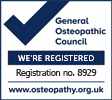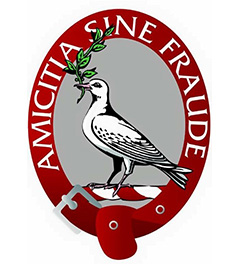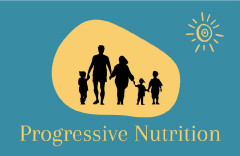Gluteus Medius: Weak buttocks ruin the runner
Gluteus medius weakness is a likely culprit in many overuse injuries
The gluteus medius should be considered in every running injury. So many athletes with running overuse injuries of the lower limb present with poor gluteus medius function that I have come to the view that the strength and function of this muscle is probably the most important active component in the achievement of a biomechanically efficient running technique. This is not so surprising when you consider that during running you are always either completely in the air or dynamically balanced on one leg. All sports injury practitioners should, I believe, be able to assess and retrain gluteus medius function.
As can be seen in the image to the right (posterior view), the Gluteus medius or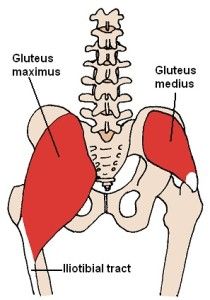 iginates at the dorsal ilium (uppermost, largest bone of the pelvis) below the iliac crest and inserts at the top outside surfaces of the greater trochanter (top of the thigh bone).
iginates at the dorsal ilium (uppermost, largest bone of the pelvis) below the iliac crest and inserts at the top outside surfaces of the greater trochanter (top of the thigh bone).
It is the major abductor of the thigh (moves the leg away from the midline of the body). The anterior fibers rotate the hip internally and the posterior fibers rotate the hip externally.
Whilst the Gluteus maximus is a hip extensor (moves your leg behind you) and is involved in the forwards & backwards tilting of the pelvis (dynamic stabilization in the sagittal plane), the Glute medius is a hip abductor (moves the leg out to the side) that plays a major role in controlling the sideways tilting of the pelvis.
Here’s the deal:
The Trendelenburg gait is exhibited by a person who through weakness in the abductor muscles, cannot maintain sufficient height of the opposite side of the pelvis to raise the foot and transfer weight to the other leg.
Instead, the pelvis drops downwards, meaning the affected person has to bend their leg more than usual at the knee in order to make up for the lack of lift.
To compensate, the stride on the unaffected side typically becomes shorter, along with a tendency for the person to lurch towards the weakened side in an attempt to maintain a level pelvis.
Does Weakness in the Hip Muscles Cause “The Hip Drop”
You might be wondering:
The term hip drop has become increasingly popular in articles today. It seems almost every runner has some level of it, and what does that even mean anyway?
In the diagram below, the drawings (A) and (B) illustrate a runner in left leg “swing phase”, meaning the left leg is off the ground and in the process of travelling forwards. The right leg is in mid-stance directly under the hips and taking maximum load as the body weight passes over it.
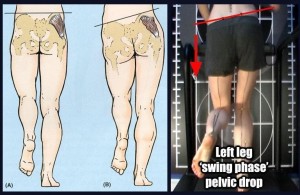
How do I strenghten Gluteus medius?
Single-leg squat
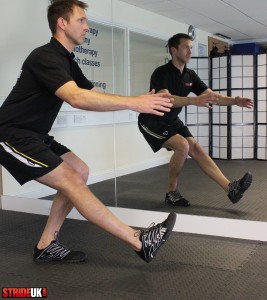
There is rarely ever just one way to perform an exercise. The method of execution will often vary according to what you are trying to achieve. In order to maximize use of the Gluteus medius (and indeed the whole of the Glute family), I personally encourage single leg squats that involve moving the centre of gravity backwards as opposed to forwards. In this case:
- The exercise is initiated by moving your backside backwards and downwards, as opposed to moving the knee of your supporting leg forwards. This can be challenging for many people as it requires a certain level of balance, coordination and flexibility.
- For this reason, the single-leg squat is often placed higher up on the ladder of exercise progression. Attempting it too early will often mean you resorting to moving your knee forwards, which in my opinion reduces recruitment of the glute muscles and puts more stress on the quadriceps muscles and knees.
- In order to encourage initiation of the exercise with a backwards shift, I often recommend clients place a suitably heighted chair behind them to give them a target and confidence in the fact that if they do lose stability they will not be falling onto a hard floor.
- If you are moving backwards, the natural position for the non-weight bearing leg will be in front of you as opposed to behind (see photo).
- As your strength and balance improves, you can progress by lowering the height of the object behind you.
- Speak to your osteopath if you feel you have gluteus weakness

